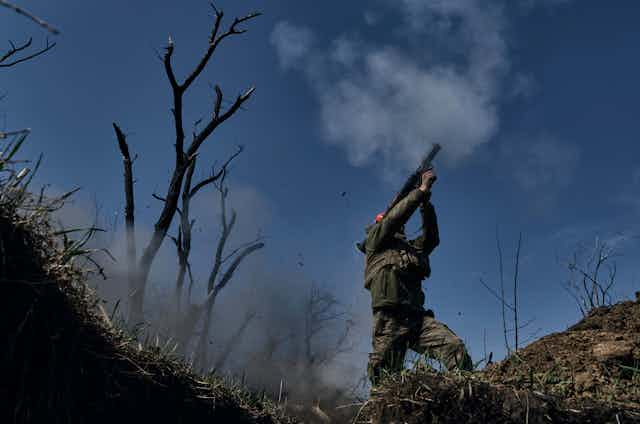The Battle for Bakhmut raging in eastern Ukraine has captured the attention of the outside world.
Despite facing overwhelming odds, Ukrainian forces have held out and inflicted severe casualties on Russian armed forces. Their resilience has also given them time to reorganize their forces and prepare for an expected spring offensive.
The problem for Ukraine, however, is that all battles eventually reach a culmination point. Ukrainian forces, in the initial phases of the battle, were able to inflict significant casualties upon Russian forces, both in terms of soldiers and hardware.
The battle, however, has shifted. Ukraine is continuing to inflict disproportionate losses on Russia. The issue, however, is that Ukraine is unable to replace its soldiers as easily as Russia.
Transformation of an army
Ukraine’s armed forces underwent significant reforms starting in 2014. Western trainers started the process of transitioning the Ukrainian army from a top-down organization to one where lower-ranking individuals, like lieutenants and sergeants, have influence.
This shift in structure gave Ukrainian forces considerable flexibility on the battlefield, which proved to be a significant advantage in the first phases of the war. Lower-ranking officers and sergeants were able to respond to battlefield developments and achieve considerable tactical and even operational success.
The structure of the Ukrainian army and the goals of the Ukrainian political establishment, however, have shifted. Those lower-ranking officers and sergeants who were responsible for the Ukrainian success have either been killed or promoted, as Ukraine has suffered upwards of 120,000 casualties.
The soldiers replacing them, while their morale is high, do not have the same training and skills as the people they’ve replaced.
Fighting for total victory
This shift is mirrored in the political sphere. Initially, the sole goal of Ukraine was to keep fighting and prevent a rapid Russian victory. That goal was achieved.
Now, the Ukrainian forces are fighting for total victory. This is a subtle, but significant, shift.
Ukraine’s initial objective was simple: do not lose. Now, as Ukrainian forces go on the offensive, they want to take back territory seized by Russia. As Carl von Clausewitz, the Prussian general who authored the 1832 classic On War once noted, that’s a much more difficult task.
This has resulted in Bakhmut taking on a significance beyond its military importance for Ukraine. Furthermore, Ukrainian-to-Russian casualties, while still favourable to Ukraine, are less so than they were at the beginning of the battle. Given the disparity in the number of reserves between Ukraine and Russia, the situation benefits Russia.

These difficulties are magnified by Ukraine’s chief battlefield opponent at Bakhmut. The Ukrainian ground forces are primarily fighting the Wagner Group, which has gone from being an elite military force to one that relies on convicts as the war has progressed.
Furthermore, tensions between the Russian army and the Wagner Group’s leader, Yevgeny Prigozhin, are well-documented.
Now Ukraine, which can less afford significant casualties, is losing soldiers to under-trained and under-equipped Wagner forces who, in many cases, are there to escape the Russian prison system.
Read more: The Battle of Bakhmut exposes Russia's fault lines
The next phase of the war
Both sides are preparing for spring offensives, meaning that soldiers and munitions are at a premium for Russia and Ukraine alike.
Russia, by losing under-trained and under-equipped Wagner Group members while Ukraine is losing well-trained Ukrainian soldiers and valuable ammunition in Bakhmut, is gaining an advantage for the crucial coming phase of the war.
Using the Wagner Group in Bakhmut has given the Russian army the chance to train the 300,000 soldiers it conscripted in the fall.
Read more: The Russian draft isn't likely to help Vladimir Putin win the war in Ukraine
The Russian army suffered significant casualties in the first year of its war in Ukraine. Russia lost key people expected to train and lead any subsequent mass conscription.
Now, instead of further falling behind in leadership and training, Russia is using the Wagner Force to buy time. Some argue the Russian army is also eliminating the Wagner Group as a competitor.
The Russian conscripts in the regular armed forces, instead of being sent directly into combat without training or equipment — as they were in the desperate autumn 2022 months — now have time to train and regroup in less prominent areas of the conflict.

Armies must stay agile
No army ever remains the same throughout a conflict. Losses, both in soldiers and munitions, force an army to constantly change and adapt. The ability to adapt to such changes is an under-studied and crucial part of any successful campaign.
Bakhmut initially appeared to be a Ukrainian strategic victory as they depleted the Russian armed forces. But the significance Ukraine has attached to Bakhmut now means that a once looming victory risks becoming a major defeat.
The Ukrainian leadership’s fixation on the city, much like Russia’s own obsession with claiming it, has increasingly become a liability. The Russian leadership, however, has adapted the means to their pursuit, whereas Ukraine is using forces it cannot easily replace.

